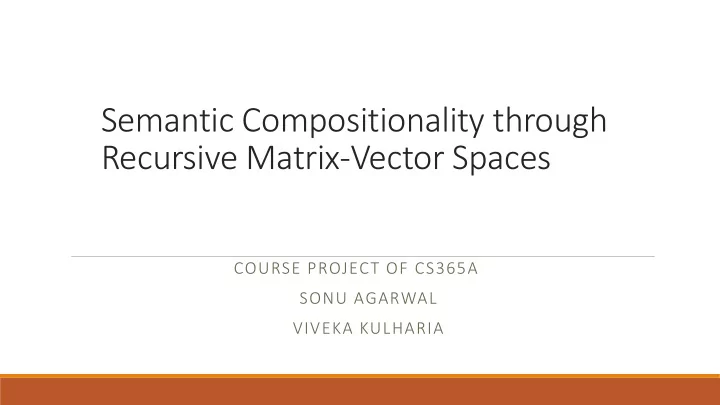

Semantic Compositionality through Recursive Matrix-Vector Spaces COURSE PROJECT OF CS365A SONU AGARWAL VIVEKA KULHARIA
Goal • Classifying semantic relationships such as “cause - effect” or “component - whole” between nouns • Examples: "The introduction in the book is a summary of what is in the text." • Component-Whole "The radiation from the atomic bomb explosion is a typical acute radiation.“ • Cause-Effect
Parse Tree Image created using www.draw.io
Binary Parse Tree Image created using www.draw.io
What’s Novel ? • We introduce a recursive neural network model (RNN) that learns compositional vector representations of vectors or sentences of arbitrary length or syntactic type • We assign a vector and a matrix to every node in the parse tree • Vector captures the inherent meaning of the word • Matrix captures how the word modifies the neighboring words • A representation for a longer phrase is computed in a bottom-up manner by recursively combining children words according to the syntactic structure in the parse tree
Recursive Matrix-Vector Model Image Source: http://www.socher.org/index.php/Main/SemanticCompositionalityThroughRecursiveMatrix-VectorSpaces
Training • Initialize all the word vectors with pre-trained n-dimensional word-vectors • Initialize matrices as , where is the identity matrix and is Gaussian noise 𝜁 𝐽 𝑌 = 𝐽 + 𝜁 • Combining two words: Ba p f , ( , ) a b f Ba Ab ( , ) g W A B Ab A P f A B , W M M B
Training • We train vector representations by adding on top of each parent node a softmax classifier to predict a class distribution over sentiment or relationship classes label d p soft max W p E s t • Error function: sum of cross-entropy errors at all node, where s is the sentence , ; and t is its tree.
Learning • Model parameters: label W W , , W , , L L M M L where and are the set of word vectors and word matrices. L M • Objective Function: E x t , ; J 1 N x t , where E is the cross entropy error and is the regularization parameter.
Classification of Semantic Relationship Image Source: reference 1
Results Dataset: SemEval 2010 Task 8 Accuracy (calculated for the above confusion matrix) = 2094/2717 = 77.07% F1 Score = 82.51% Code Source: http://www.socher.org/index.php/Main/SemanticCompositionalityThroughRecursiveMatrix-VectorSpaces
Reference 1. Semantic Compositionality through Recursive Matrix-Vector Spaces, Richard Socher, Brody Huval, Christopher D. Manning and Andrew Y. Ng. Conference on Empirical Methods in Natural Language Processing ( EMNLP 2012, Oral ) 2. Composition in distributional models of semantics, J. Mitchell and M. Lapata Cognitive Science,34(2010):1388 – 1429 3. Simple customization of recursive neural networks for semantic relation classification, Kazuma Hashimoto, Makoto Miwa, Yoshimasa Tsuruoka, and Takashi Chikayama 2013 In EMNLP.
Recommend
More recommend